The highest hereditary title in the Portuguese nobility. By tradition, there are a total of five royal and seven non-royal dukes in Portugal, out of 28 dukedoms that have ever been created. In the majority of cases, the title of duke was attributed to members of the high nobility, usually relatives of the Portuguese royal family, such as the second son of a monarch.

Count of Cantanhede was a Portuguese title of nobility created by a royal decree, dated from 6 August 1479, by King Afonso V of Portugal, and granted to D. Pedro de Menezes, 5th Lord of Cantanhede.
DomMichael of Braganza was a Portuguese infante, illegitimate son of King Pedro II of Portugal and of the French lady Anne Armande Pastre de Verger. Miguel was recognized by his half brother, King John V of Portugal, who demanded he should be regarded as his brother. He was born in Lisbon on 15 October 1699 and died drowned in the Tagus River on 13 January 1724.

Duke of Lafões is a Portuguese title of nobility created under the decree of February 17, 1718, of King John V of Portugal and granted to his nephew, Dom Pedro Henrique de Bragança, the building force behind Palacio do Grilo and first son of Infante Miguel de Bragança, the latter an illegitimate son of King Peter II of Portugal and Anne Armande Pastre de Verger. Pedro's mother, Luisa Casimira de Sousa Nassau e Ligne was the first to use this title. The title was later passed on to his brother, João Carlos de Bragança e Ligne de Sousa Tavares Mascarenhas da Silva, the most famous Duke of this title.

Count of Linhares was a Portuguese title of nobility created by a royal decree of king John III of Portugal dated from May 13, 1532, and granted to Dom António de Noronha, 2nd son of Pedro de Menezes, 1st Marquis of Vila Real.
Hugo José Jorge O'Neill was the head of the O'Neill Clandeboy dynasty, which ruled a kingdom in Gaelic Ireland until the early 17th century, and has been in Portugal since the 18th century.

Marquis of Vila Real was a Portuguese title of nobility created by a royal decree, dated from 1 March 1489, by King John II of Portugal, and granted to Dom Pedro de Menezes, also known as Peter II of Menezes, 3rd Count of Vila Real.

The Dukes of Miranda do Corvo was a Portuguese title of nobility granted by Queen Maria I of Portugal, by a royal decree dated from May 13, 1796, to Dom José João Miguel de Bragança e Ligne, 1st Duke of Miranda do Corvo, who died in 1801, before his father, João Carlos de Bragança e Ligne de Sousa Tavares Mascarenhas da Silva, 2nd Duke of Lafões.

The Duke of Palmela is a Portuguese title granted by royal decree of Queen Maria II of Portugal, dated from October 18, 1850, to Dom Pedro de Sousa Holstein (1781–1850), a Portuguese politician during the first half of the 19th century. He was President of the Council of Ministers and a remarkable Ambassador in London and to the Congress of Vienna.

Duke of Faial was a Portuguese title of nobility, named for Faial Island in the Azores, which was granted by royal decree of Queen Maria II of Portugal, dated from 4 April 1833, to Pedro de Sousa Holstein, a 19th-century politician who served as Portugal's first prime-minister. Two months later, on 16 June, Sousa Holstein successfully petitioned the Queen to change the title from Duke of Faial to Duke of Palmela, which he used for the rest of his life.

Marquis of Valença was a Portuguese title of nobility granted by royal decree of King Afonso V of Portugal, dated from October 11, 1451, to Dom Afonso of Braganza (1400–1460), who already was 4th Count of Ourém. It is the 1st Marquis title in Portugal.

Count of Alcoutim was a Portuguese title of nobility, subsidiary to the one of Marquis of Vila Real, created by a royal decree, dated from November 15, 1496, by King John II of Portugal, and granted to Dom Fernando de Menezes, also known as Ferdinand II of Menezes, 2nd Marquis of Vila Real, 4th Count of Vila Real and 2nd Count of Valença.

Count of Vila Real was a Portuguese title of nobility created by a royal decree, in 1424, by King John I of Portugal, and granted to Dom Pedro de Menezes, also known as Peter I of Menezes, 2nd Count of Viana.

The noble title of Marquis de Arronches was created on 27 April 1674 by D. Afonso VI of Portugal for Henrique de Sousa Tavares, 3º conde de Miranda do Corvo. The heir presumptive to the title is the only male descendant of the family, D. Pedro Vasques Milhinhos, who due to primogeniture will be the only one eligible to succeed D. Aires Manuel to the title.

Count of Valença was a Portuguese title of nobility, created by a royal decree, dated from July 20, 1464, by King Afonso V of Portugal, and granted to Dom Henrique de Menezes, who was already 3rd Count of Viana and 4th Count of Viana.

Count of Vila Verde was a Portuguese title of nobility created by a royal decree, dated from December 10, 1654, by King John IV of Portugal, and granted to Dom António de Noronha, 12th Lord of Vila Verde.

The Sousa family is an ancient Portuguese noble family. It is considered to be one of the eldest and most noble houses in the Kingdom of Portugal.

Luís de Sousa was Archbishop of Lisbon. He was a major figure of the second half of the seventeenth century, serving as Royal Chaplain and Councillor of State of Portugal, later being created a Cardinal by Pope Innocent XII in 1697.

D. João Carlos de Bragança e Ligne de Sousa Tavares Mascarenhas da Silva, 2nd Duke of Lafões, 4th Marquis of Arronches and 8th Count of Miranda do Corvo was a Portuguese nobleman and politician. He was the marshal general of the Portuguese Army, which he commanded during the War of the Oranges.
Pedro Henrique de Bragança e Ligne de Sousa Tavares Mascarenhas da Silva , 1st Duke of Lafões was a Portuguese aristocrat, visionary and intellectualist of the 18th century who served as a magistrate in the role of Regent of Justice in the courts of Kings D. John V of Portugal and D. Joseph I of Portugal. Profoundly religious, the 1st Duke of Lafões was also the driving force and artistic vision behind Palacio do Grilo. This fact is closely related to being one of the strongest pretenders to the hand of the future Queen D. Maria I of Portugal, as well as the other uncle of D. Maria I - legitimate descendant of D. John V, D. Pedro III.










